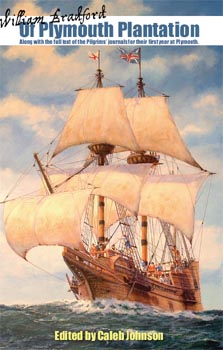William Latham
BIRTH: About 1609, possibly at Amsterdam, possibly the son of William and Elizabeth (Johnson) Latham, who were originally from “Chierbory”, perhaps Chirbury, Shropshire.
MARRIAGE: Mary, sometime before 1643.
CHILDREN: None.
DEATH: About 1648 at Eleuthera, Bahamas.
William Latham came on the Mayflower in 1620 as an 11-year old servant/apprentice to the John Carver family. There is a William Latham baptized on 4 February 1608/9 in Eccleston by Chorley, Lancashire, England, son of Hugh and Eline Latham that would be the right age. Eccleston by Chorley is the area Myles Standish came from. But more probably William Latham is the son of William and Elizabeth (Johnson) Latham, members of the Ancient Brethren Congregation in Amsterdam.
After the death of John Carver in April 1621, William Latham appears to have finished out his term of service with William Bradford. He was still in the Bradford household at the time of the May 1627 Division of Cattle. Latham was taxed 9 shillings in both 1633 and 1634, the lowest tax rate. In July 1633, Myles Standish was appointed to mow the land owned by William Latham and Edward Bumpass. In July 1635, William Latham witnessed a deed for Edward Bumpass who was selling his land to John Washborn. In 1636, Myles Standish was granted the use of land neighboring that owned by Washborn and Latham, provided he mow it but leave enough for Washborn's one cow.
In 1638, William Latham had a couple of brushes with the Plymouth Court. On June 5, he was fined 40 shillings for the "entertaining of John Phillips into his house contrary to the act of the Court" and for "lavish and slanderous speeches." Jonathan Brewster was a witness against him. By September, Latham had only paid half the fine. On December 4, 1638, Latham still owed 11 shillings, and was ordered not to depart Plymouth Colony without first obtaining a license. The debt was paid 6 January 1639. On 6 July 1638, William Reynolds sold half of his share of a black cow to John Phillips, and John Phillips then sold William Latham all his crop of Indian corn. On 26 December 1639, William Latham sold his house and property in Duxbury, and apparently moved to Marblehead, in the Massachusetts Bay Colony. In 1641, he deposed he was about 32-years old, and testified in a lawsuit between John Moses and Thomas Keyser. About 1643, he moved to Marshfield, where he is found on the 1643 list of men able to bear arms.
On 24 February 1643/4, a warrant was issued against William Latham’s wife Mary for adultery. Governor Edward Winslow of the Plymouth Colony wrote:
Whereas divers and sundry complaints have come in to me from Weymouth sent and delivered by godly and credible persons against Mary the wife of William Latham late of Marblehead but now at Marshfield for adultery committed upon the body of the said Mary by one James Brittain of Weymouth. And having apprehended the said Mary and examined her, have sent her with the examination according to my duty to that Government where the fact was committed.
On 28 October 1645, William Latham and Roger Cooke sued John and Ann Baker for £20, for Ann's accidental burning of their house. The jury could not reach a verdict, but John Baker agreed to pay 20 shillings for damages.
The accidental burning of Latham's house is the last record of him in Plymouth Colony. At some point he became associated with William Sayle’s adventure to settle a colony, based on freedom of religion, at Eleuthera, Bahamas, arriving there about 1647. The colony failed after the colonists had a dispute and split up to settle separate islands. William Latham reputedly starved to death there about 1648.



